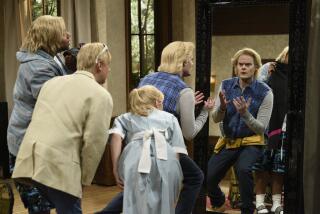Past Comes Back to Haunt ‘Seinfeld’
This is my final “Seinfeld” column.
I know, I know. It comes as a shock.
For weeks now, I have been keeping the content secret. Security has been so tight that even I had no idea what I’d be writing.
I knew that coming up with that last column would be a difficult task. Lots of expectations. Lots of emotions. Lots of false starts. The Times considered bringing back my predecessor, former television critic Cecil Smith, to help me write it. His genius and graceful prose are legendary. But he’d spent the last nine years watching public television.
I didn’t want to make a fuss about the final column. Larry King would have called. Talk shows would have called. Local stations would have called. President Clinton would have called. My mother would have called.
Someone would have asked me to list my top 10 “Seinfeld” columns. Or I would have been swamped with requests to cite the most influential phrases from my “Seinfeld” columns, such as “master of my dominant tendency to pander” or “not that there’s anything wrong with writing 168 columns on the same topic.” I have to admit, just seeing that in print brings a tear to my eye. Which is exactly the kind of emotional farewell I’d have been in for had I said yes when Katie Couric called.
The significance of my final “Seinfeld” column would have been blown far out of proportion. It would have overshadowed even Jerry Springer. You know how the media are.
*
Yada shmada.
You knew that “Seinfeld” was ready for Mt. Rushmore when American University in Washington, D.C. sent out a mailer last week listing a historian and two other assistant professors who were available to comment on the planet’s most famous, most mentioned, most media-blessed, most give-it-a-rest-already sitcom. Shouldn’t they have been grading papers or talking about Proust?
What must they be thinking now following Thursday night’s “Seinfeld” finale, an event that would not have matched soaring expectations for it had Jerry Seinfeld opened the show by parting the Red Sea. As it turned out, in keeping with its relatively flat ninth season, the final “Seinfeld” did not part even the Hudson. Or Kramer’s hair.
It had its moments, and its concept was clever enough. But it delivered many fewer yucks than yadas. The 45-minute howl of a retrospective that preceded the finale worked against it, in effect, by reemphasizing just how breathtakingly funny and unique “Seinfeld” had been, compared with how meekly it was bowing out despite its gifted cast, led by Seinfeld, Jason Alexander (George), Julia Louis-Dreyfus (Elaine) and Michael Richards (Kramer).
Written by “Seinfeld” co-creator Larry David, who returned for this send-off, the plot kept to the broad outlines reported in a Boston Herald gossip column Wednesday:
Five years after shelving “Jerry,” the series “about nothing” dreamed up on a whim by Jerry and George, NBC was giving it a 13-episode pickup and, as a bonus, letting them use a company jet. So off to Paris the euphoric Jerry and George flew, with Elaine and Kramer on board, too, only to have the craft forced to land in Latham, Mass., where all four were arrested for not coming to the aid of a man they observed being carjacked. As George would remark later: “Why would we want to help somebody? That’s what nuns and Red Cross workers are for.”
And so, after nine seasons of callousness, greed, selfishness and indifference to the pain of others, their sins finally came back to haunt them, for converging on Latham to testify against them at the big show trial were oodles of “Seinfeld’s” memorable fifth bananas whom they had abused in some of the show’s wittiest, most memorable episodes.
Thus did David create a device to recall those highlights via both clips from past episodes and testimony on the stand, the funniest coming from the Bubble Boy (don’t ask) and the Soup Nazi, the fascistic entrepreneur who complained to the jury that because of Elaine, he had to close his business “and move to Argentina.”
Even the shiftiness of their lawyer, Jackie Childs (Phil Morris), could not save Jerry and his pals from a guilty verdict and a sentence of a year in the clinker. The episode’s closing minutes were its best, with the four friends schmoozing as vacuously inside a holding cell as they did inside the restaurant where they hung out. And finally, there was Jerry, in his orange prison suit, sublime as ever while doing his signature stand-up comedy in front of George, Kramer and the rest of his fellow jailbirds:
“So what is the deal with the yard? . . . And what is it with the lockdown?”
It’s those ending big laughs that are especially worth recalling, along with other dazzling stretches during this comedy’s stunning spectacular run.
*
Now that I’ve finished my final “Seinfeld” column, it’s only proper to complete the circle by printing an excerpt from my first “Seinfeld” column.
Appearing in The Times on May 31, 1990, it was a review of the first episode, which I said blew up “a gale of wit and freshness.”
I also called it “just the kind of amusingly off-center comedy now missing from NBC’s lineup, one of those rare delightful meshings of concept, cast and execution . . . “ In other words, I wrote, “Great stuff.”
Of course, this was only a callow initial effort to capture “Seinfeld,” composed before I had acquired the experience and pomposity to indulge in the kind of knee-jerk overstatement that my “Seinfeld” writings would later become famous for.
But even then you could see that I had the potential for triviality.
More to Read
The complete guide to home viewing
Get Screen Gab for everything about the TV shows and streaming movies everyone’s talking about.
You may occasionally receive promotional content from the Los Angeles Times.






